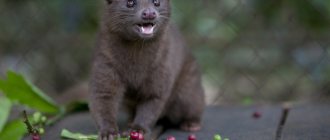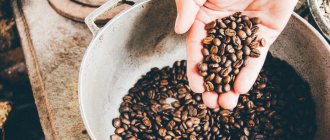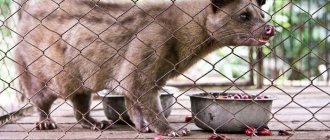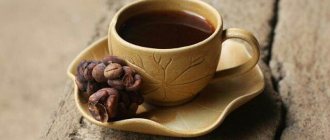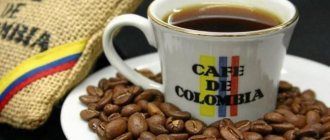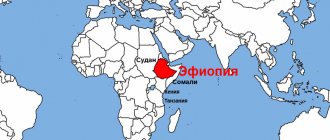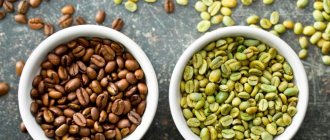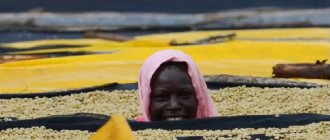Origin of Luwak coffee
An interesting fact: the emergence of elite coffee is associated with the taxation system in Indonesia. Traders and local residents were forced to pay high taxes when exporting grains due to the colonialists. As a result, they decided to use a trick: they began to give coffee to the civets. This is a medium-sized animal that visually resembles a hybrid of a cat and a raccoon. After crossing the border, coffee beans were washed out of the dung and sent for sale or brought as a gift.
At the same time, there is a legend that the Luwak variety appeared by chance. According to legend, one day a peasant harvested grains, but palm martens got to the bags and ate most of them. The poor peasant, having lost most of his harvest, fell into despair, but then saw that the animals left excrement. Whole grains with intact shells were visible in the feces. The peasant washed the rest of the harvest, sold it and became a local legend, since for a long time no one could reveal the secret of the special aroma and taste of the drink.
The method of making coffee would have been forgotten, but one circumstance prevented this. Under the influence of gastric enzymes, the taste of the grains changed greatly. The variety was in great demand, so it was later produced on a large scale.
What's special about it?
The second common name for this type of coffee is Kopi Luwak. It is considered one of the most valuable and unique in the world. And every coffee lover has heard about this drink, even if he hasn’t tried it yet. Admiring gourmets say: elite, premium, with a soft, unique taste, with notes of caramel, with a subtle aroma of chocolate and vanilla, and finally, the most expensive in the world...
One cup of this coffee in a Dalat cafe, for example, costs about 700 rubles.
How can you not want to taste it! But first I would like to know what this “elite beast” is. And yes, further our story will go mainly about animals. More precisely, about small furry animals. “What does coffee have to do with it?” - you ask. Yes, it’s true, it’s hard to imagine that animals can do it. But this is true. However, this could not have happened without the help of specially trained people.
What animal droppings can the drink be made from?
There are several ways to prepare coffee. In the traditional version, musang is involved in the production process. More exotic methods include processing grains by monkeys, birds and even elephants. Depending on the chosen method, the quality of the drink may differ.
Musangi
Coffee beans are part of the musanga's natural diet. The animal spends most of its life in trees. There it hunts small game and hides from larger predators. On occasion, musangs do not refuse to eat coffee cherries. The variety obtained in this way is called Kopi Luwak.
Producing the drink using musanga is expensive for companies. The problem is not only that animals need to be kept somewhere. After the grains pass through the stomach, only 5% of the total volume remains intact. This will already increase the price of coffee by at least 20 times. Additionally, the beans are carefully sorted, selecting only grains of the correct shape and the same size. This further reduces the yield of finished products.
The classic Kopi Luwak is made in Indonesia. Musangs are also found in Ethiopia, but it is believed that local coffee does not have such a rich aroma and taste. This is due to differences in climatic conditions.
Vietnamese Luwak coffee is identical to traditional coffee, but is brewed using a different method.
Elephants
Blake Dinkin invented a different way to produce coffee: using elephants. The founder of Black Ivory Coffee Corporation believes that musangs are not suitable for keeping in captivity, so the traditional method of production is unethical. Elephants tolerate human interaction better and even enjoy joint activities. Blake Dinkin approached the issue responsibly: he involved scientists and veterinarians in the process. The company's founder assumed that elephants could absorb some of the caffeine from the beans, but his fears were not confirmed. The substance is absorbed at temperatures from +70 ˚C.
Dinkin organized production on the territory of a Thai nature reserve. He suggested feeding the elephants coffee cherries along with fruits and cane. Thanks to this trick, the grains are imbued with a sweet aroma and sugar, which has a positive effect on the taste. The product is fermented more strongly during the process, since the digestion process in elephants lasts on average 1 day. Another advantage of the method is economy. More whole grains can be found in elephant feces than in musang feces.
Coffee production volumes are small. Only 30 elephants are involved in the process. The drink is ordered in advance and you wait in line. You can try freely available coffee in expensive hotels in Abu Dhabi and the Maldives, as well as in the north of Thailand. Small quantities are sold through retail chains in Phuket. Dinkin donates about 10% of total profits to the elephant protection fund.
Monkey
In China and India, monkeys are involved in the coffee production process. Plantations are located in Taiwan and Karnataka. The grains are prepared using rhesus monkeys and a Taiwanese endemic monkey. These monkeys previously raided and devastated plantations; later, local residents figured out how to wash the coffee out of their feces and put it on sale.
Monkeys not only eat the pulp of the fruit, but also chew the outer shell. Thanks to this, enzymes enter the core, which makes the taste of the drink more intense. The product differs from the classic version in its greater sweetness and notes of vanilla and caramel.
Birds
In Brazil, in the southeast, there are birds that look like guinea fowl. They are called jaku. Pheasants are listed in the Red Book, but in their habitat they often devastate coffee plantations. Farmer Enrique Sloper fought an unsuccessful fight against the jacu for several years until he noticed that the birds were specifically selecting the largest ripe berries. He washed the coffee out of the feces, carefully cleaned and crushed it, after which he brewed the drink and was shocked by the pleasant taste.
Sloper is now the owner of Camocim Organic Coffee. Those who have tried the coffee describe it as fruity with a chocolate-anise aroma. The taste contains unobtrusive notes of coconut milk, lemon balm and black bread.
What kind of coffee is in Vietnam?
In addition to the fact that there is a lot of coffee here, it is roasted in unusual ways (for example, with sweet syrups), thanks to which it acquires a unique sweet-chocolate taste. And they serve coffee in any cafe: thick and aromatic, with ice and an additional glass of delicious green tea. Coffee is the most popular drink in Vietnam.
Ordinary Vietnamese coffee shop: price for a glass of coffee - 12,000 dong ($0.5), green tea with ice - free
Ice coffee with condensed milk: an unforgettable taste!
Vietnam has two varieties of beans: Robusta and Arabica . Robusta is much more popular; you can often find blends based on Robusta with a small addition of Arabica. In Nha Trang, you can find many shops on the street where the coffee beans you choose will be ground right in front of you and sealed in a bag - in my opinion, a great gift for family and friends!
There are a great variety of such stores: you choose beans (you can mix varieties in any proportions), and they grind and seal them right in front of you
The most popular brand of coffee in Vietnam can be called Me Trang (read as Mechang). Shops of this company can be found on every corner in tourist Nha Trang. Mechang coffee is really tasty, but we didn’t notice much difference compared to little-known brands of coffee from the Vietnamese market.
The most famous coffee brand in Vietnam today is Me Trang
In addition to Robusta and Arabica, the type of coffee known as Luwak (or Luwak) is also found everywhere in Vietnam. These are ordinary coffee beans that have passed through the gastrointestinal tract of one very cute fur-bearing animal.
What is this super trendy Luwak coffee made from animal feces in Vietnam? What does it smell like, and most importantly, how did people get there?
Manufacturing procedure
The animals are offered coffee berries and left for a while. Elephants do not eat the product in its pure form, so it is mixed into their main food. After some time, farmers collect the feces and grains and wash them thoroughly with plenty of water. After processing, the coffee is dried in the sun to prevent rotting processes. Additionally, the grains can be roasted. Packaging varies depending on the manufacturer. For example, Jacu Bird Coffee is placed in small foil bags with a valve and jute bags.
Processing disputes
At that time, the standards for harvesting and processing coffee beans were nowhere near what we have today.
When harvesting coffee, it is very important that the berries are completely ripe . As with other fruits, this ensures that your sugar levels reach their peak.
The animals prefer ripe berries, which suggests that in the wild the palm marten would be more selective than the workers of the Dutch plantations. But this is just a guess.
The process of processing coffee, at its core, is to remove the pulp from the berries before they begin to rot.
As a matter of fact, this happens in the animal’s stomach within 30 hours.
It is quite possible that this combination of careful selection of berries and efficient processing of coffee beans from the pulp made this coffee the best available at that time. However, it is worth remembering that the accepted processing standards back then could not compare with those now used by specialty coffee producers.
Features of cooking in different countries
The main suppliers of Luwak coffee are Indonesia, Vietnam and the Philippines. In these countries, grains are processed differently. Differences depend on geographical features and local traditions.
Indonesia
In Indonesia, coffee production is done responsibly. Farmers wake up early in the morning, when the sun is not yet warming the soil, to find fresh droppings. Once suitable faeces are found, collectors contact buyers. The latter examine the feces and determine the quality of the grains. If they are not damaged, have the correct shape and are large enough, farmers are paid a reward, and animal waste products are sent for production.
The droppings are washed out as quickly as possible. It is believed that this allows you to get the highest quality product. The water remaining after flushing is sent for analysis to ensure that the feces came from a wild animal.
Vietnam
In Vietnam, the quality of the beans is much worse. The digested grains here come from captive animals. Their diet is not adjusted for the better: producers buy inexpensive food and give the animals too many berries. Another problem is fraud. Sellers often mix Luwak with cheap varieties and sell it under the guise of elite coffee. The share of processed grains in this case is 1–5%.
Philippines
The Philippine production method is more similar to the Indonesian one. Here, farmers also manually collect faeces from wild animals. However, the population of local civet cats is rapidly declining due to the production of civet perfume. For this reason, it is difficult to purchase Philippine coffee and it rarely appears on sale.
Do you want a legend in the best Asian traditions?
Telling how the amazing properties of Luwak coffee were unexpectedly discovered.
It is believed that musangs choose only the most delicious grains.
A terrible disaster befell one peasant family: wild musangs completely ate the harvest of ripe grains for sale. But the Vietnamese miraculously discovered undigested grains and were able to obtain coffee from animal feces. Extreme poverty forced the peasants to wash this find and, after roasting it, put it up for sale as regular coffee. And their surprise was great, because an incredibly delicious taste was obtained!
Characteristics of Luwak coffee
Kopi Luwak is a coffee that has an unusual taste. This is due to the long fermentation process and the penetration of sugary substances into the grains. Animals that eat coffee eat sweet fruits. Substances from the fruit, under the influence of gastric juice and high temperature, enter the kernels of the grains, changing their properties.
Taste qualities
Depending on the variety, the taste differs. Most varieties are characterized by the absence of the usual bitter and sour notes. The taste is sweetish, soft. Connoisseurs describe it as creamy chocolate. The aroma ranges from fruity to caramel, with a hint of cocoa.
Differences from Arabica
Luwak is less strong than Arabica. Its taste is not so tart, but it has more notes, it does not open up right away. The average cost of Luwak coffee is much higher than the price of Arabica coffee. The latter drink is much easier to find on sale.
Where are the coffee plantations in Bali?
Most of the coffee plantations where you can find Kopi Luwak are located on the road leading to Kintamani (mark on the map). There are several plantations there, we counted at least 5; on the road, as a rule, there is a large sign with the inscription Kopi Luwak.
There are not many accommodation options near the plantations; one of the few hotels nearby where you can stay is the Bali Eco Advanture Resort. You can see other options here.
Effects of coffee from feces on the human body
Luwak affects the body in much the same way as other types of coffee. However, due to its enriched composition, long fermentation and low caffeine content, it is considered healthier. Such grains are better suited for people who experience problems with the cardiovascular system. However, during exacerbations or the last stages of pathologies, the drink should not be consumed.
Benefits and harms
Among the beneficial properties of coffee are the following:
- Enriching the body with vitamins and minerals. The product contains potassium, cobalt, manganese, chromium, phosphorus and magnesium. It contains B vitamins in small quantities. Its consumption helps combat nutrient deficiency, although coffee is not capable of becoming the main source of microelements.
- Antioxidant effect. Grains prevent unwanted oxidative processes. They help relieve inflammation, slightly strengthen the immune system, and prevent the formation of malignant tumors. Drinking coffee in moderation slows down aging.
- Providing a surge of energy. The drink stimulates the central nervous system. This facilitates concentration, increases performance and makes a person more resilient for a short time. It becomes easier to cope with complex technical problems. For example, with driving a car.
- Reducing the risk of developing diabetes. The product reduces tissue resistance to insulin. This allows the hormone to have a stronger effect on cells and normalizes blood sugar levels. The pancreas no longer has to produce insulin in large quantities. By reducing the load on the organ, its condition improves.
- Improved blood circulation. The drink acts on the cardiovascular system as a stimulant. After consuming it, blood circulation increases. It carries oxygen and nutrients, so all tissues, cells and organs are better saturated. This has a beneficial effect on the general condition.
Coffee is recommended to be consumed only by well-rested people. In this case, they use all available resources to obtain better results. It is advisable not to take the product if you have insomnia, sleep disorders and frequent awakenings, including after sleep. If you have poor rest, coffee will temporarily smooth out the effects a little, but will worsen the exhaustion of the body due to its stimulating effect. This will lead to even more sleep disturbances. Due to the caffeine content, the product is not recommended for use in the evening.
The drink can cause harm if there are contraindications or excessive consumption. The daily norm is considered to be 2–4 small cups per day. If the dosage is exceeded, increased sweating, heart palpitations, anxiety and restlessness are observed. In severe cases, hallucinations and disorientation occur. With prolonged abuse, generalized pathologies develop against the background of general exhaustion and deterioration of the central nervous system, as well as the cardiovascular system.
Contraindications for use
Contraindications to drinking coffee include:
- breastfeeding period;
- sleep disorders;
- mental disorders, including neuroses, panic attacks, obsessive-compulsive syndrome, etc.;
- pathologies of the stomach and intestines, gastroesophageal reflux disease;
- uncontrolled hypertension;
- glaucoma;
- iron deficiency anemia;
- liver pathologies accompanied by a violation of its functionality.
The list of relative indications includes pregnancy. If possible, it is better to give up coffee during this period; if this is not possible, you should limit yourself to 2 cups per day. It is prohibited to drink the drink while taking certain antidepressants and oral contraceptives. Substances contained in medications negatively affect the absorption and elimination of caffeine from the body.
It is not recommended to combine Luwak and smoking. You should choose one thing so as not to bring the load on the cardiovascular system to a critical level.
The history of the discovery of the most expensive coffee drink
It all started on the island of Sumatra. Several centuries ago, it was one of the territories used by the colonialists. At that time, they imposed a large tax on local residents for the supply of coffee. Therefore, people had to flush out the coffee beans from the droppings of a pest animal called “luwak”, which is similar to a lemur.
Over time, residents noticed that a drink made from grains that had undergone a fermentation process in the stomach of a rodent turns out to be refined and unusual in taste. It was then that the variety of this coffee with the Indonesian name “kopi luwak” was born, which today is rated quite highly. Interestingly, this industry subsequently brought people out of the crisis.
An animal in whose stomach grains undergo a fermentation process is called luwak.
Cost of Luwak coffee
The most expensive coffee in the world costs an average of 20 thousand rubles. for 1 kg. The price of grains differs depending on their quality and country of origin. Indonesian coffee is the most highly valued: for 1 kg you will have to pay 40 thousand rubles. The main supplier of cheap grains is India. The cost of their products is reduced to 15 thousand rubles. for 1 kg.
What is the reason for this price?
The high cost of grains is due to the complexity of the manufacturing process. First of all, it requires animals that will ferment the coffee. They need to be maintained, feed purchased and their health monitored if controlled production is planned. Related costs have to be included in the cost of the final product so as not to go into the red.
Another problem is low output. Only 5–10% of the initial volume of beans reaches sale. Half-digested particles are rejected immediately: if they accidentally end up in the packaging, the manufacturer’s reputation will be damaged. Additionally, uneven or too small grains are removed.
Luwak is a rare type of coffee. Musangs are not distributed throughout the world, but only in some areas. In the wild, they do not always feed on coffee fruits. Farmers have difficulty finding suitable samples, and strict screening reduces production even further. Even if you keep animals on your own, you won’t be able to prepare a lot of grains: the animals’ diet should consist of more than just berries. Coffee fruits are given inconsistently or mixed into portions in small quantities.
So why?
How is it that this myth still exists? Well, for the same reason why Kopi Luwak made it into the movies in the first place.
This is a ready-made headline for the yellow press. It’s too funny not to chat about at the water cooler at work or share on your favorite social network.
In some ways, it's not much different from the stories of Einstein and ostriches.
How can we put an end to this stupid idea? First, you can go ahead and share this story on your social networks. Some people might be upset by this news, but if it's necessary to save animals and improve the quality of coffee tourism in Indonesia, I'll get through it somehow.
about the author
Hi, I'm Asser Christensen from Denmark, founder and editor of THE COFFEE CHRONICLER. For as long as I can remember, I have always been crazy about coffee. Today I am a licensed Q-grader and professional coffee writer.
Varieties of Luwak coffee
The classic variety is Kopi Luwak. However, in addition, manufacturers produce other varieties of fermented coffee: Jacques Bird, Black Ivory, Coffee Terra Nera, etc. They differ in their preparation methods, taste and aroma.
Black Ivory
Black Ivory translated means “Black Tusk”. This variety is prepared by fermenting the raw material in the stomachs of elephants. The variety is considered one of the most expensive: the cost starts from $1,080 per 1 kg. It is impossible to find it on open sale; you can buy or order grains only from the manufacturer’s reserve. The drink can be tried in luxury hotels in Thailand.
Coffee Terra Nera
To make Coffee Terra Nova, the fruits are offered to civet cats. Their stomach enzymes give the product a nutty-chocolate aroma. Coffee lovers compare it to cocoa and hazelnuts. The production volumes of the variety are small, so the price of 1 kg of product reaches 1.5 thousand dollars. This variety can only be found for sale in an elite coffee shop in London. Each batch is packaged in custom-made silver and gold-plated bags made by jewelers. A gold tag is attached to the outside. If desired, you can engrave your name on it.
Jacques Bird
Birds are involved in making Jacquou Bird. Most often these are local guinea fowl. Sometimes berries are offered to gray parrots: they are more amenable to taming and tolerate captivity well. The birds are not locked in cages; they are given the opportunity to roam freely. Roasted grains have the aroma of molasses and toasted black bread. The cost of 1 kg of products is 400–500 dollars.
How much does the most expensive coffee cost?
The price of Luwak coffee starts from $600 per 1 kilogram of product. The most expensive and most delicious drink, according to connoisseurs, can be made from Vietnamese grains. 1 kg of such a fermented product costs at least $7 thousand. The price of elite grains is determined by some production features:
- Staff costs are high. Employees need to be paid. Often workers live on farms, which requires food and maintenance costs. The owner is forced to pay for the services of a veterinarian who monitors the health of the animals.
- The owner of the production combines 2 farms in one. The owner is obliged to take care not only of animals, but also of plants.
- The lack of technology in extracting grains from manure slows down the production process. You can get a small portion of the product per day.
- You can give coffee to animals no more than 2-3 times a week. The basis of the animals' diet is soups made from chicken broth with the addition of corn and rice. The civet's stomach is not capable of processing large portions of coffee. Excess grains will not receive the necessary taste and smell.
- The animal chooses the fruits independently. Civets only eat ripe cherries. Fruits that animals refuse to eat must be disposed of. This increases costs. On some plantations, animals are invited to choose fruits directly on the branches.
Kopi Luwak coffee obtained from wild animals can be more expensive than beans from farmed animals. This is due to the need to search for excrement. However, drinking such a drink is not always safe for humans. The animal that ate the fruit may have been unwell.
Some farms offer Luwak tasting. A cup of Luwak costs $5. However, many farms cooperate with coffee packaging companies, and visitors may be offered a pre-packaged product.
You can purchase luwak outside the countries of production in specialized stores. The seller must have a license to sell such products. Due to the high risk of counterfeiting, you should not buy the drink online. You should not purchase a product with big discounts, New Year promotions, etc. Genuine Luwak cannot be cheap.
Interesting! Various popular types of coffee, their descriptions and methods of preparation in coffee shops
How to make your own Luwak coffee?
You can prepare coffee in several ways: with spices, according to a Vietnamese or classic recipe. Seasonings and their proportions must be selected with care so as not to overwhelm the taste of the drink.
With spices
To make coffee, take 1 clove star, 0.5 tsp. ginger and 5 pcs. cardamom Pour 3 tsp into the mixture. ground grains. The workpiece is filled with 250 ml of water at room temperature. The Turk is placed on low heat and the foam is allowed to rise, then the vessel is removed from the stove. The procedure is repeated twice, then the liquid is filtered.
Vietnamese recipe
To make coffee you will need a filter press. It is placed above the cup. Pour 2-3 tsp into the filter. ground grains and thoroughly compacted, then slowly pour hot water. Liquid is added until the cup is full. Coffee is drunk immediately after preparation.
In Turk
The turk is heated, then 2 tsp is added. ground coffee. You can add 1-2 tsp to taste. Sahara. The workpiece is heated for 30–60 seconds to enhance the smell, and 250 ml of water is added. The coffee is boiled over low heat until the foam rises, and at the end it is filtered.
Contraindications
It is not recommended to drink the drink for those who suffer from high blood pressure, insomnia, glaucoma, kidney failure and a number of other diseases. Of course, this does not mean that you need to completely stop using it. It must be kept to a minimum. Since coffee contributes to a sharp increase in cholesterol levels, it is contraindicated for those who already have this indicator above the norm.
The vast majority of any coffee drink causes physical and psychological dependence, so it is better not to abuse Luwak coffee, even for a healthy person.
CIVETS AND HUMANS
The civet family are animals with beautiful fur. The meat of these animals is edible. In China, civet meat is considered a delicacy, despite the fact that scientists have discovered a virus in the blood of one species of civet that causes pneumonia. Civets sometimes become pets. If tamed from a young age, they become as much loved furry friends as cats and dogs.
photo: Tamed civets
MUSANG AND KOPI LUWAK COFFEE
In human life, civet cats played the role of supplier of an expensive product - Kopi Luwak , also known as Kopi Luwak. This type of coffee comes from the Musang , which is found in the southern and southeastern regions of Asia. Musang, he is a common musang, he is also a Malayan palm civet , he is also a Malayan palm civet , not to be confused with the palm civet, these are two different genera. Musang is a lover of delicious, ripe coffee berries. After passing through the animal's digestive tract, coffee berries are not completely digested, but are only fermented and excreted in feces. Fermentation partially destroys the coffee-specific bitterness from regular beans. Coffee made from beans that have been processed in the musang body acquires a mild taste. This type of coffee, Kopi Luwak, is a very expensive coffee.
photo: Musang on a coffee tree
CIVET
In medicine and the perfume industry, the waste product of some types of civets is used - civet, or civet. Civet (musk) is the secretion of the glands of animals, with which they mark their territory. Civet is a very strong-smelling liquid with an unpleasant odor. Civet contains the odorous substance civeton, or civeton, which, when strongly diluted in alcohol, acquires a pleasant aroma. Civet is used as a fragrance or aroma fixative for perfumes, eau de toilette and cologne.
SECURITY VIVERR
Owston's civet, Kalimantan civet, Sulawesi civet, South Indian musang - have the status of a vulnerable species. Otter civet and crested genet have endangered species status. The Malabar civet is in critical condition. All these species are listed in the International Red Book.
photo: Civets.
back to top
